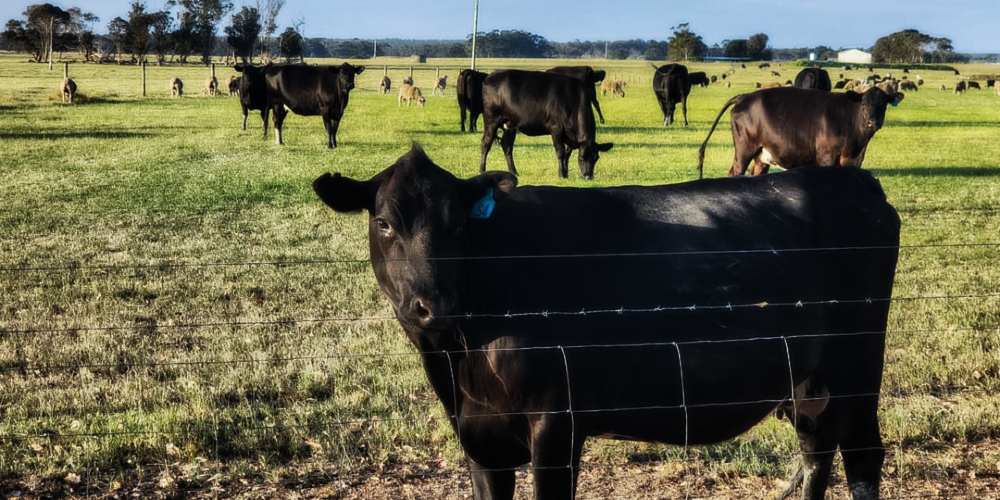(The Epoch Times)—A controversial measure to include $15 million for the electronic tracking of livestock has made it through Congress via the recently passed omnibus bill, raising fears among critics that the new system could be weaponized by the government to limit beef consumption.
American cattle rancher Shad Sullivan told The Epoch Times that he fears that the electronic tags will be the end of the small rancher.
“They are going to use it as a taxing mechanism to eventually control the livestock,” Mr. Sullivan said. “In the European Union, they used these measures under the guise of climate change lies to limit the cattle supply, and if they do that here, it will destroy our industry.
“If the tag mandate is implemented it will be the key to open the door to the gas chamber for independent ranching.”
Rep. Thomas Massie (R-Ky.), who owns livestock, also sounded the alarm that the move could lead to the erosion of the industry.
“The left wants to ban cattle and before you can ban anything you need a registry, you need to know where it’s at and who owns it and that’s why they want to tag cattle,” he said in a March 23 post on social media platform X, formerly known as Twitter. “We’ve seen it happen in Europe.”
In a previous post, Mr. Massie wrote that, if passed, the electronic tracking “will be used by the GREEN agenda to limit beef production, and by the corporate meat oligopoly to DOMINATE small ranchers.”
The omnibus bill, which was passed on March 22, combines six essential spending bills into one and includes text that allocates $15 million to “related infrastructure” needed for the program.
The full text of the provision reads: “The agreement directs the Department to continue to provide the tag and related infrastructure needed to comply with the Federal Animal Disease Traceability rule, including no less than $15,000,000 for electronic identification (EID) tags and related infrastructure needed for stakeholders to comply with the proposed rule, ‘Use of Electronic Identification Eartags as Official Identification in Cattle and Bison,’ should that rule be finalized.”
Since its initial proposal last year, the mandate for electronic ear tags for cattle and bison crossing state lines has stirred controversy, particularly among small ranchers. They fear that the added costs, which large corporate ranchers can absorb, will drive many smaller operations out of business.
Currently, most livestock are tracked using tags that display 11-digit numbers, which are both visible and trackable. On Jan. 19, 2023, the Federal Register published proposed regulations to mandate the inclusion of radio-frequency identification in ear tags. These enhanced tags must be “both visually and electronically readable” to be recognized as official for the interstate movement of cattle and bison.
“Livestock,” under the regulation of the U.S. Department of Agriculture’s Animal and Plant Health Inspection Service; includes all sexually intact cattle and bison 18 months of age and older; all female dairy cattle of any age; all male dairy cattle born after March 11, 2013; cattle and bison of any age used for rodeo or recreational events; and cattle and bison of any age used for shows or exhibitions, according to the proposal.
Since 2003, following the discovery of the first case of bovine spongiform encephalopathy, also known as mad cow disease, in the United States, ranchers have been pushed to adopt electronic identification tags for livestock movement. The cattle industry has been gradually advancing toward enhanced traceability rules and technology ever since.
However, the federal mandating of electronic ear tags would place unnecessary and punitive costs on American ranchers while also further raising the price of beef, according to Justin Tupper, president of the U.S. Cattlemen’s Association.
“It is another example of ridiculous spending,” Mr. Tupper told the Epoch Times. “If they are going to use these funds to hand out free tags to those who would want them then there would be no real harm, but that is not what it looks like they are doing here.
“Instead they are going to give them to the big tag companies to shove down our throat to mandate it, which is an entirely different thing.”
A new mandate on livestock would only add another obstacle to an industry already decimated by regulations and drought.
The beef cattle supply has already dropped to its lowest point in decades, raising the price of beef to another all-time high and renewing concerns over the long-term health of the nation’s farming community. A series of severe droughts, coupled with government policies that continue to favor large, industrial food processors, has reduced the nation’s supply of beef cattle to a level not seen since the early 1950s, according to Mr. Tupper.
Lawmakers slipped the funding for the electronic ear tag infrastructure into a single paragraph in the omnibus bill, which allowed lawmakers to pass legislation without the scrutiny that would normally occur and is another example of the increasingly intrusive role the federal government has in the lives of the independent ranchers, he said.
“Anything that is mandated we are going to push back very hard against,” Mr. Tupper said. “We always have to be aware of who controls the data.
“We are well aware of the fact that data can exert a tremendous amount of control over the nation’s livestock.”
The provision could also be the beginning of the end for the independent American rancher, according to Mr. Sullivan.
“The beef industry is the last bastion of freedom,” he said. “Ranchers across the nation have to stand up. If not, these tags will be the end of the small rancher.”



